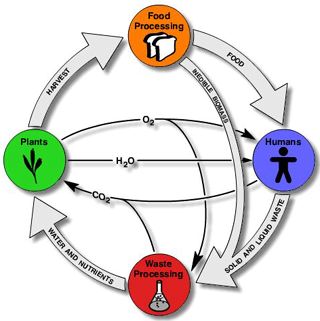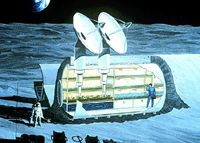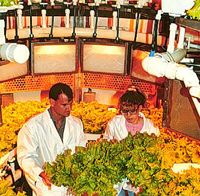Goals for the BioBLAST© multimedia software development project:
(1) To design and develop a curriculum supplement that incorporates current research regarding teaching and learning and is consistent with national educational reform efforts currently underway.
(2) To provide much needed, classroom-based research regarding how state-of-the-art information and communication technologies enhance student learning.
(3) To demonstrate how NASA's Space Life Sciences research can provide valuable and motivating resources to enrich student learning and performance in science, math, and technology education.
(1) Provide an underlying theme that emphasizes the inter-relatedness of living things and also represents a challenging scientific problem which students are invited to respond to as researchers, designers, and explorers. Students will learn that they are researching and suggesting solutions to a problem that NASA scientists and engineers are currently trying solve.
(2) Provide both an experimental and theoretical model for teaching biology as a study of living systems. Through their interactions with the CELSS simulation, students can see how plant growth and harvesting can be designed to provide food, oxygen, and water supplies to sustain human life in a desolate lunar environment. Students will also learn the importance of designing ways to recover and recycle vital substances from human and plant waste in order to sustain a regenerative system. This curriculum will be presented in a manner that will require students to collaborate and communicate within and across groups. When working on experiments and research activities, some students will explore content areas in depth, and will become the class experts on these topics. Students will have to share their expertise and data in order to design their own model for a regenerative system.
(3) Engage students in activities that require higher order thinking skills. When students discuss the human conditions associated with life on a remote, lunar habitat, they must consider the human and social ramifications of science and technology applications.
(4)
(5)
(6) Provides a strong core theme that unites a variety of scientific disciplines, including mathematics, technology education, chemistry, psychology, sociology, with all of the biological sciences. The events which occur during the adventure/simulation experience and questions asked during the mission debriefing will require students to apply what they have learned to interpret new situations in other disciplines and to evaluate the experience from the perspective of more than one discipline.
Link to National Science Education Reform Movement

 Provide a context for learning that focuses on the future. As suggested in the national guidelines, not in the sense of predicting the future but preparing young people to help plan the society and their own lives for living, learning, and working in the world in which they will be spending their lives.
Provide a context for learning that focuses on the future. As suggested in the national guidelines, not in the sense of predicting the future but preparing young people to help plan the society and their own lives for living, learning, and working in the world in which they will be spending their lives.
 Include ways to learn through hands-on experiences and direct manipulation and observation activities. Hands-on laboratory experiences will be a central part of this curriculum and will be used to emphasize key concepts by providing students with multiple exposures to central processes Students will have to defend the hypothesis behind their experiment before they conduct their experiment, and will be able to compare their results with other students throughout their research. The final adventure/simulation activity will require students to apply and share with their peers what they learned from their laboratory experiences to the overall context of CELSS and research strands within this larger context.
Include ways to learn through hands-on experiences and direct manipulation and observation activities. Hands-on laboratory experiences will be a central part of this curriculum and will be used to emphasize key concepts by providing students with multiple exposures to central processes Students will have to defend the hypothesis behind their experiment before they conduct their experiment, and will be able to compare their results with other students throughout their research. The final adventure/simulation activity will require students to apply and share with their peers what they learned from their laboratory experiences to the overall context of CELSS and research strands within this larger context.
(1) more performance-oriented pedagogies and more communal school organizations support higher levels of student success(2) teacher teach from what they understand and believe about learning, what they know how to do, and what their environments will allow
(3) the kinds of teaching behaviors that produce high scores on tests of recall and recognition were decidedly different from those that produced high scores on assessments of writing, problem solving, student independence in learning, and critical thinking
